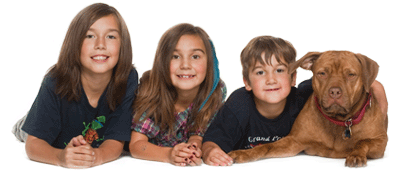Dogs & Kids
All interactions between dogs and children should be carefully supervised.
If the dog is getting too excited, teach the children to stand still “like a tree;” fold arms and hide hands, then walk away slowly and calmly.
Teach your children how to appropriately interact with dogs:
- Allow the dog to approach you, not the other way around!
- Pet the dog under the chin or chest.
- Don’t look directly into the dog’s eyes.
- NEVER approach or touch a strange dog
- Never disturb a dog who is eating, chewing or sleeping
- Do not allow children to climb on the dog, hug tightly, pull the tail, or grab feet
- Keep your children’s faces away from the dog’s face.
Look for these warning signs that a dog is anxious:
- The dog is standing stiffly.
- He is looking sideways at the child.
- He is trying to get away or hide.
- His tail is tucked.
- He emits a low, deep growl.
- He is staring your child in the eye, with a raised lip.
Most Importantly:
- Never run from a dog; the natural instinct will be to chase.
- If a dog does run up to you, freeze with your arms folded or by your sides. Once the dog loses interest, walk away slowly.
- Don’t scold a dog for growling – this is his way of communicating and should be listened to.
RESPECT YOUR DOG – and encourage others to do the same…a dog will respond in kind. Your new pet is your friend and companion. Forcibly moving him, hitting or pinning him down will lead to problems. The dog may see you as a threat, as someone to fear, and may shut off from you or become aggressive. Your pet should welcome your touch and not be afraid of you.

